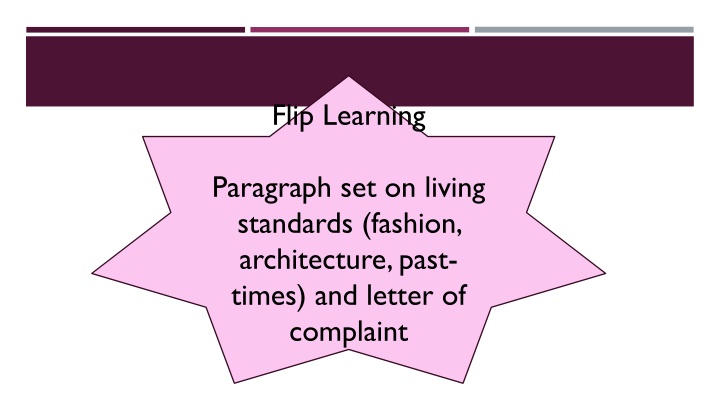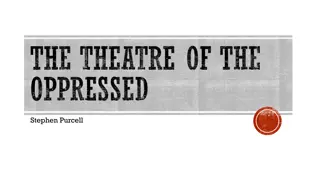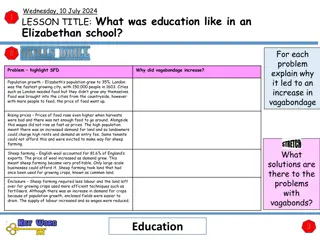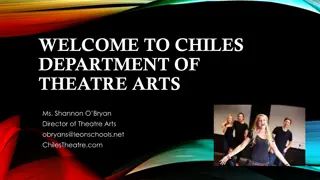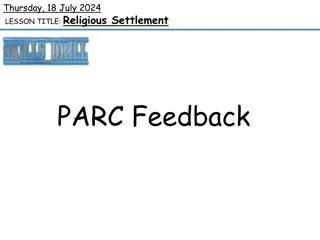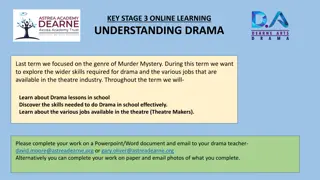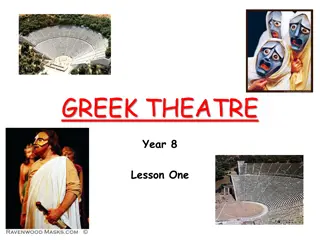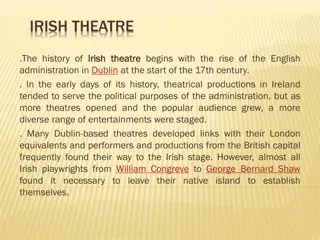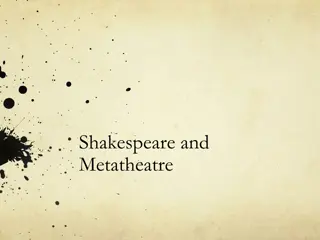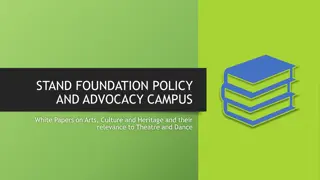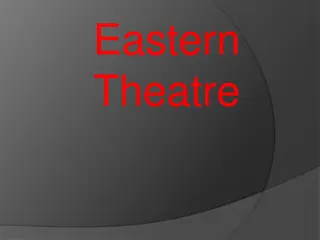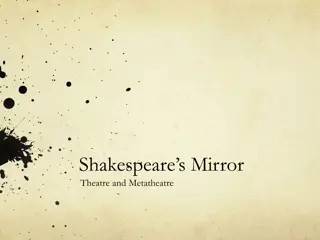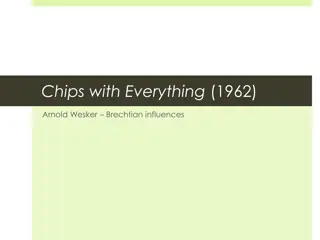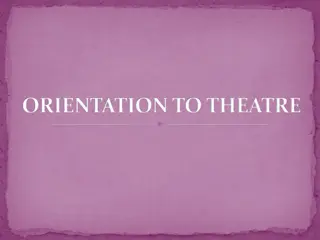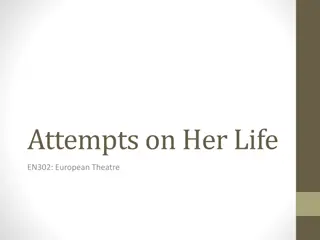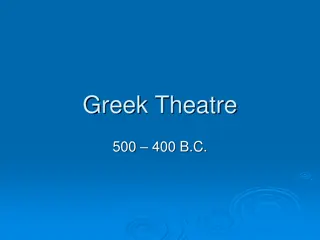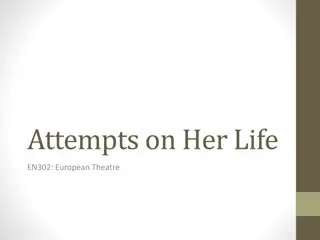Elizabethan Theatre: The Globe & Its Significance
Historical backdrop of Elizabethan theatre, focusing on The Globe Theatre in 16th-century England. Understand the impact of societal norms, architecture, and cultural values on theatrical development.
Download Presentation

Please find below an Image/Link to download the presentation.
The content on the website is provided AS IS for your information and personal use only. It may not be sold, licensed, or shared on other websites without obtaining consent from the author.If you encounter any issues during the download, it is possible that the publisher has removed the file from their server.
You are allowed to download the files provided on this website for personal or commercial use, subject to the condition that they are used lawfully. All files are the property of their respective owners.
The content on the website is provided AS IS for your information and personal use only. It may not be sold, licensed, or shared on other websites without obtaining consent from the author.
E N D
Presentation Transcript
Flip Learning Paragraph set on living standards (fashion, architecture, past- times) and letter of complaint
STARTER Name as many things you can remember about Elizabethan theatre as you can remember without looking at your notes go!
THE GLOBE THEATRE ELIZABETHAN ENGLAND 1568- 1603
ELIZABETH LESSON 11: HARDWICK HALL (16 MARK QUESTION) Even better: Great learning: Good learning: Evaluate why Elizabeth s government encouraged the development of theatre Explain how and why the Globe Theatre was significant Understand the history of the Globe Theatre Key Words:
THE GLOBE THEATRE WILL BE THE FOCUS OF A QUESTION ON YOUR EXAM Question 04 on the Elizabeth paper will be on the Globe Theatre The question is a 16 Mark question and so will make a big difference to your final mark. You will be expected to display a large amount of knowledge. You will need to evaluate aspects of the Globe Theatre in relation to other things you have learnt about Elizabethan England. You will need to make a judgement and explain it.
THE FOLLOWING ASPECTS OF THE SITE SHOULD BE CONSIDERED: location function the structure people connected with the site eg the designer, originator and occupants design how the design reflects the culture, values, fashions of the people at the time how important events/developments from the depth study are connected to the site.
HIGHLIGHT KEY INFO ON THE SHEET THINK ABOUT The first and second theatre that was built The Globe and its location
BACKGROUND INFO ON THE GLOBE After Henry Vlll broke with Rome, medieval mystery plays were banned because of their close connection to Roman Catholicism First London Theatre was the Red Lion but was little different from the previous tradition of playing in courtyards of inns. It was also a long way for audiences to travel The second purpose-built theatre called The Theatre , was built in 1567 by James Burbage in Shoreditch, just outside the city limits to the north-east of London However, The Theatre was built on land which belonged to a Puritan and when the lease ran out they refused to renew it. However, Burbage knew there was a clause in the lease which said what was on the site belonged to him this led to him and labourers dismantling the theatre in the middle of the night so it could be reassembled later It was reassembled by the acting company the Lord Chamberlain s men which included the Burbage brothers, Shakespeare and 3 other men all of whom had shares in it. It was assembled at Bankside in Southwark on the south bank of the River Thames in 1599 and was called The Globe ,
BACKGROUND OF ELIZABETHAN THEATRE https://www.youtube.com/watch?v=P0SBg-KG4C4 Watch this video and make notes on your sheet in answer to the questions https://www.youtube.com/watch?v=m3VGa6Fp3zI
Image result for A drawing of the Globe theatre LABEL THE DIAGRAM Using pages 38-39 identify the key design features
WHO PERFORMED PLAYS? Read the handout and highlight any key bits add these to your diagram of make a note of them in your books
WHO PERFORMED PLAYS? Only men could perform in plays. Actors who contributed money to the company were called sharers and received a share of the profits from performances Other actors called hirelings were paid a weekly wage While boys who played the women s roles were apprentices and were paid very little In 1583 the Earl of Leicester s Men lost some of their best actors to a new company put together by Sir Francis Walshingham the Queens Men The Lord Chamberlains Men William Shakespeare joined this company as an actor and principal playwright in 1594, writing on average two new plays a year for them The biggest rival to Lord Chamberlain s Men was another company The Admirals Men and they played at the Rose Theatre which was the first theatre to be built on Bankside in Southwark, South London.
PATRONAGE + THEMES & CENSORSHIP Using pages 40 & 41 on Patronage and Themes and censorship, make detailed notes and answer the question How and why did Elizabeth s government encourage the development of the theatre in this period?
PATRONAGE BRIEF SUMMARY Attitudes of Elizabeth and her advisors changed in the 1570 s (actors originally seen to be immoral) Attitudes or Elizabeth and her advisors changed in 1570 s = instead of seeing the theatre as a threat, the government started to see its potential for propaganda and also for encouraging social stability Less of a chance of rebellions Influence the thoughts and feelings of the audiences in favour of the Queen and her government
THEMES/CENSORSHIP BRIEF SUMMARY Some plays contained subtle political messages that were designed to flatter Elizabeth and support her position They were also carefully censored so as to not be too controversial or to make any obvious references to politicians at the time The Elizabethans believed everyone and everything had its own place in a hierarchy called the Great Chain of Being (Shakespeare's plays emphasised this) The Privy Council realised the potential of plays for propaganda or treasonable slander which is why all plays had to be approved of before performance or publication In 1597, a play the Isle of Dogs was immediately banned by the Privy Council and three of the actors arrested. No copies of the play survive but it was thought that the satirical comedy had made slanderous comments about the Queen Plays also had a part in the Essex Rebellion of 1601 that arose from the rivalry at Court between the Essex and Cecil factions
ATTENDING THE ELIZABETHAN THEATRE HIGHLIGHT KEY POINTS FROM YOUR HANDOUT ABOUT ATTENDING THE ELIZABETHAN THEATRE
ATTENDING ELIZABETHAN THEATRE Different coloured flags indicated what type of play would be performed (white flags = comedy, red signalled a historical play, black = tragedy) Theatres could accommodate over 2000 people Widely varied audience Without the protection of patrons and the support of the London public, the achievements of the Elizabethan theatre would have been impossible The playwrights and actors held in low esteem in the early part of the reign had, by its end, risen socially and responded to the aspirations of their audience and the Elizabethan age
GLOBE BURNS The original theatre was burned down in June 1613, when a fire was started by a cannon during a performance of Shakespeare's Henry Vlll Today, a modern reconstruction of the Globe Theatre stands about 750 feet from the original site of the Elizabethan theatre = it opened in 1997
location Outside the city walls Southwark (South Bank of the Thames) Theatre/Plays FLIP LEARNING function (what was it used for) the structure Use diagram, think why that structure was used Who designed the Globe, who went to the Globe, famous playwrights, the Queens involvement Social hierarchy, Patronage, Censorship, Audience Produce a complete guide to the Globe Theatre using the textbook, your own notes and the handouts people connected with the site eg the designer, originator and occupants how the design reflects the culture, values, fashions of the people at the time how important events/developments from the depth study are connected to the site. This must be DETAILED!!! Include >>>>
The main cause for the growth of Theatres in Elizabethan times was their importance in promoting Elizabeth and her propaganda How far does a study of support this statement? Explain your answer. You should refer to The Globe Theatre and your contextual knowledge. [16 marks] The development of Theatres in Elizabethan England was a dramatic cultural change How far does a study of support this statement? Explain your answer. You should refer to The Globe Theatre and your contextual knowledge. [16 marks]
Introduction What is your answer to the question and why? Paragraph 1 For (Agreeing with the statement in italics) PEE Introduction What is your answer to the question and why? Paragraph 1 For (Agreeing with the statement in italics) PEE Introduction What is your answer to the question and why? Paragraph 1 For (Agreeing with the statement in italics) PEE Introduction What is your answer to the question and why? Paragraph 1 For (Agreeing with the statement in italics) PEE Paragraph 2 Against (Another change/reason that might be more important) PEE Paragraph 3 Against (Another change/reason that might be more important) PEE Conclusion Reassert your judgement (from introduction) and prove why you are right! Paragraph 2 Against (Another change/reason that might be more important) PEE Paragraph 3 Against (Another change/reason that might be more important) PEE Conclusion Reassert your judgement (from introduction) and prove why you are right! Paragraph 2 Against (Another change/reason that might be more important) PEE Paragraph 3 Against (Another change/reason that might be more important) PEE Conclusion Reassert your judgement (from introduction) and prove why you are right! Paragraph 2 Against (Another change/reason that might be more important) PEE Paragraph 3 Against (Another change/reason that might be more important) PEE Conclusion Reassert your judgement (from introduction) and prove why you are right!
